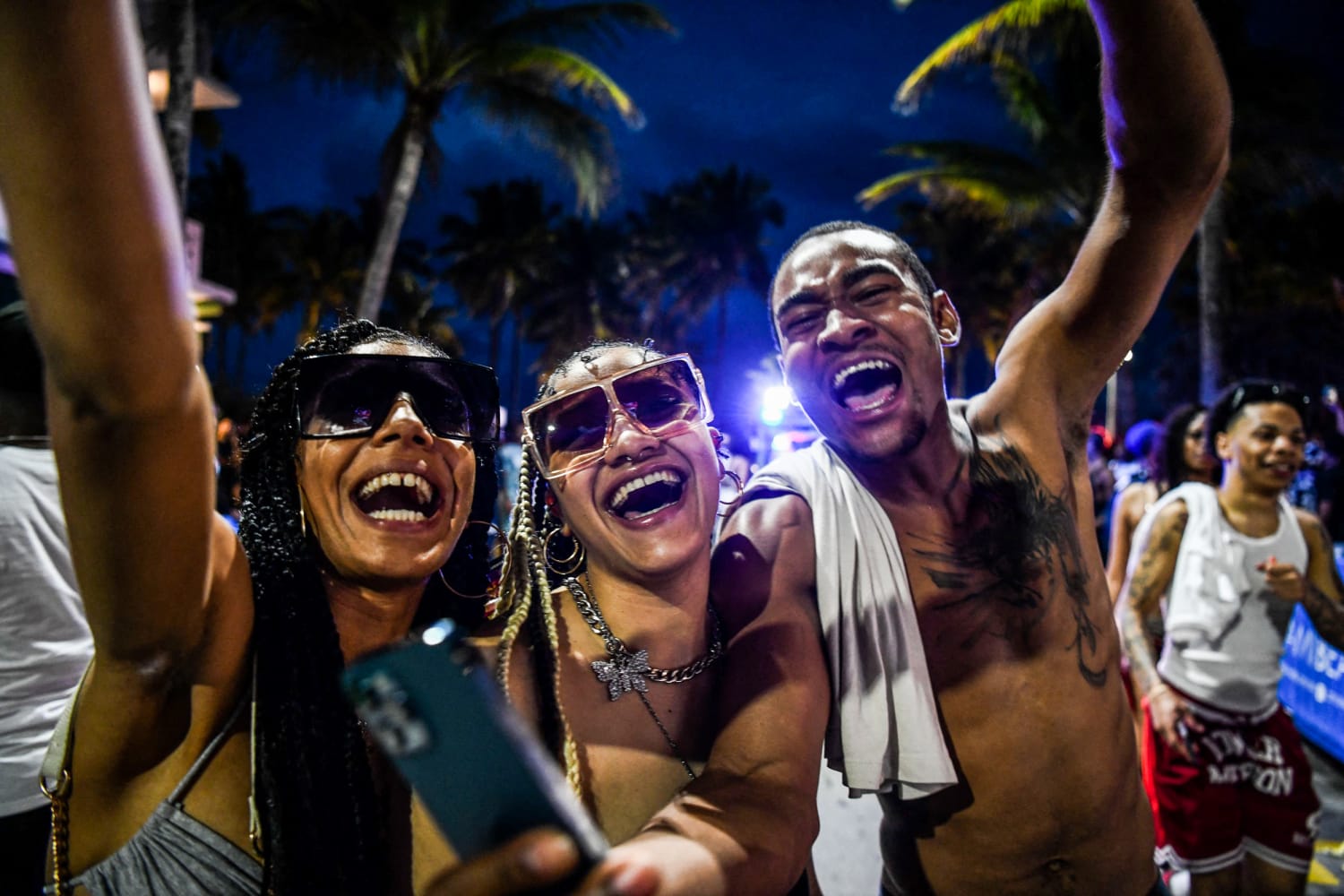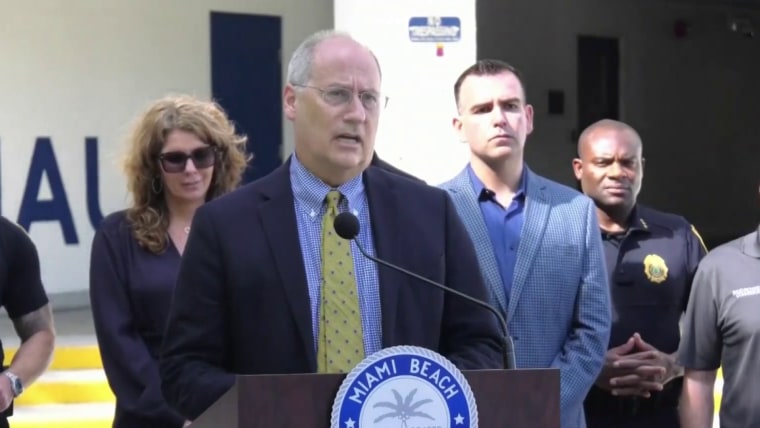There’s never been anything delicate about Miami Beach, Florida. It’s always had a rogue streak. It’s still Miami vice, sex, drugs and thrills. In the past 20 years, the city has tried to modify that image, promoting the arts, museums, a book fair — but its hardcore identity as a wild and crazy beach town has endured.
It’s not that spring break revelers don’t bear any responsibility for the state of affairs. But the reaction puts the entire onus on them when the reality is much more complicated.
That reputation lures masses of college students on spring break and undesirable elements whom the city manager, Alina Hudak, called “random people.” It’s a party-tough crowd, with packs of night crawlers and derelicts on sidewalk corners.
That foul atmosphere exploded in two separate shooting incidents during spring break this month on the main drag of Ocean Drive, where five people were wounded, leading the city to declare a state of emergency. A five-day midnight curfew was imposed Thursday in the city’s South Beach area, while sales of alcohol were banned after 6 p.m. Businesses, restaurants, dance clubs and bars had to cease operating at midnight.
“We can’t endure this anymore. We just simply can’t,” Mayor Dan Gelber, a Democrat who won a third term in November, said at a news conference March 21. “This isn’t your father’s, your mother’s spring break. This is something totally different. We don’t ask for spring break, we don’t promote it, we don’t encourage it, we just endure it, and frankly it’s something we don’t want to endure.”
Gelber’s words, however, ring a little hollow. Several Miami political and business leaders are unfairly blaming outsiders for the chaos and violence, when it’s in part their own policies and homegrown image that are the problem.
It’s not that spring break revelers don’t bear any responsibility for the state of affairs. But the reaction puts the entire onus on them when the reality is much more complicated. For instance, everyone quickly connected the shooting incidents to spring break, as they happened where the spring break crowds were concentrated. But not every suspected shooter has been arrested, and it’s unclear whether they were out-of-towners or locals. And either way, locals as well as out-of-towners converge in this disruptive fashion during spring break.
Moreover, the underlying conditions that allow these crowds to gather are pushed by many local interests. So while voters in November approved a nonbinding referendum to cut back drinking hours permanently from 5 a.m. to 2 a.m, it’s faced predictable opposition from clubs and hotels, like the Clevelander on Ocean Drive, which has sued the city.
In a separate case, the high-end Papi Steak, in affluent South Pointe, an area also under curfew, and Treehouse nightclub sued the city to stop the curfew order. A circuit judge recently upheld it.
The blame-shifting also has a racial dimension. Black people make up many of those in the beach crowds, and critics say the city has overreacted to the presence of a largely Black crowd. “The only emergency in Miami Beach is that there were Black people there,” said Stephen Hunter Johnson, a member of Miami-Dade’s Black Affairs Advisory Board, according to The Associated Press. (Gelber denied the assertion that his call for a state of emergency was racially motivated.)
Tension between residents and Black visitors is nothing new. It dates back at least to the 1930s and ’40s, when Blacks weren’t allowed to live or even sleep in Miami Beach. But since the 2000s, Black crowds have been coming to South Beach, particularly during spring break and Memorial Day weekend.
Some locals have been at pains to stress the current disorder is well contained.
“To be clear, this is happening in a very small section of Miami Beach,” said Jonathan Plutzik, owner of The Betsy Hotel on Ocean Drive and chairman of the Ocean Drive Association. “It is certainly getting a lot of attention and the city leadership is, properly, dealing with it decisively. But it is having little or no adverse impact on business, except in the immediate area where the spring breakers are gathering.”
That may be so, but the 10-block stretch of Ocean Drive and the Art Deco District around it are not just peripheral neighborhoods. With shops and hotels, tourist malls, splashy bars and clubs, it is crucial to Miami Beach’s multimillion-dollar tourism-driven economy.
The city finds itself at a critical juncture. What feeds it could end up killing it, making it a victim of overtourism and its own excesses. Lax noise and liquor ordinances, permissive gun laws, ineffective zoning and building codes all contribute to the problem. In this easygoing resort atmosphere, where officials and locals tend to look the other way, regulations are too often unenforced or ignored.
That’s in part because for all the problems, Miami Beach thrives on the party scene. It even boasts about it. International tourists come to Miami at the rate of 5.2 million a year, making the greater city second only to New York City in the annual number of foreign visitors it receives. Those numbers don’t include the tens of thousands of visitors from other states. And whether it’s the disruptive crowds on Ocean Drive or the moneyed players in South Pointe, they nearly all come to party.
The urbanist Richard Florida called it “blotto-tourism,” when “people travel to an area to party and get drunk.” The part-time resident of Miami Beach is a professor at the University of Toronto and author of “The Rise of the Creative Class” and “The New Urban Crisis.” He said Miami Beach is ripe for reinvention.
The city needs to control tourist behavior, limit noise, reduce drinking hours and cut back or do away with cheap hotels and short-term lodging. Florida pointed to overrun cities like Barcelona, Spain; Rome; and Palm Springs, California, as success stories. With little expense, he said, the city could transform Ocean Drive and seaside Lummus Park across it into a livable area with open-air markets, food trucks, farmers markets, outdoor health and wellness activities, and arts and crafts.
The city finds itself at a critical juncture. What feeds it could end up killing it, making it a victim of overtourism and its own excesses.
That’s exactly the kind of thing Gelber and allies in the private sector and tourism industry are trying to do with far-sighted proposals to turn Ocean Drive into a promenade of galleries, designer shops, fine dining and residential development.
“Miami and Miami Beach’s brand and reputation have often been defined as a great late-night party town,’’ Plutzik said, but he said the seeds of transformation have already been planted. “We may be that, but we have become so much more.”
He pointed to Art Basel, the annual confab that attracts international collectors and gallerists; the Miami Book Fair; multiple food festivals; and the Aspen Ideas conference on climate change.
It’s a brave vision, but it’s not at all clear that this place is ready for such a culture change. For the millions who continue to come here on holiday or just for a day trip, it’s still the beach, the sun and the high life that draws them — at least until it all goes dark.
Source: | This article originally belongs to Nbcnews.com










